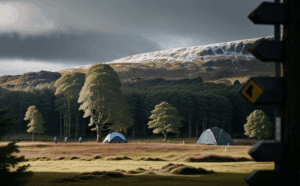Residents of Loch of Clunie, near Blairgowrie, are expressing deep concern over the escalating problem of uncontrolled camping and anti-social behavior near their homes. A local mother, Emily, has shared her experiences of verbal abuse and indecent exposure by visitors, highlighting the significant distress this is causing to the community. The situation is particularly acute during weekends and periods of good weather, with large groups congregating, leaving behind considerable amounts of litter and damaging the natural environment.
The ongoing issue isn’t just about litter and unsightly mess; Emily reports that the area surrounding her home is frequently used as an impromptu toilet, causing both hygiene and health concerns. Loud music, late-night parties, and carelessly discarded bonfires are also major problems, disrupting the tranquility of the area and impacting the quality of life for residents. The lack of immediate action leaves the community feeling increasingly vulnerable and abandoned. The regular clean-up efforts required by the community are not only time-consuming and frustrating, but also highlight a larger issue of responsible land use and the impact on local communities. Council’s Response and Existing Legislation
Perth and Kinross Council, responsible for managing visitor activity around Loch of Clunie, has acknowledged the residents’ complaints. They’ve stated that a multi-disciplinary team, encompassing community support officers and parking wardens, is undertaking patrols in the area. The council also stresses the importance of reporting any incidents of threatening behavior to Police Scotland. However, the council’s statement acknowledges that the existing “right to roam” legislation, which is essentially a set of guidelines rather than enforceable law, limits their capacity to prevent camping itself.
A local councillor, Ian, a former resident of the area, is actively seeking solutions. He’s contacted council leadership and relevant departments, pressing for a more proactive approach. He believes that the area’s designation as a Site of Special Scientific Interest (SSSI) and a Special Area of Conservation (SAC) might offer avenues for stricter enforcement. Several possibilities have been suggested, including exploring by-laws to restrict alcohol consumption in the vicinity, or revisiting existing legislation on trespassing, such as the Trespass (Scotland) Act 1865, to address the issue of prolonged unauthorized camping and the associated anti-social behavior. This highlights a wider discussion on balancing public access with environmental protection and the needs of local residents. Community Impact and Future Strategies
The lack of effective enforcement has led to a sense of frustration among the Loch of Clunie residents. The situation is exacerbated by what they perceive as inaction on the part of the council, given the frequency and severity of the problems experienced. Their concerns underscore the need for a balance between protecting access to Scotland’s beautiful landscapes and ensuring the safety and well-being of those who live in and around these areas. The current situation is unsustainable and potentially dangerous, potentially leading to accidents or more serious incidents if left unaddressed.
The council’s advice to residents to avoid direct confrontation with disruptive visitors while reporting incidents to the police raises questions about the effectiveness of this approach. While caution is important, the current lack of proactive measures to address the root causes of the problem leaves residents feeling vulnerable and unprotected. This situation has become the subject of local media coverage and has prompted wider discussions on how to better manage visitor access to Scotland’s natural beauty.
Moving forward, the situation necessitates a comprehensive strategy involving the council, Police Scotland, and the local community. Collaborative solutions that consider both the “right to roam” and the legitimate concerns of local residents are needed to ensure the Loch of Clunie area remains a safe and enjoyable place for everyone, preserving both its natural beauty and the peaceful lives of those who call it home. Further community meetings and consultation efforts are crucial to develop an effective strategy that respects everyone’s rights and responsibilities. The current lack of effective solutions is a matter of serious concern for many local residents, demanding prompt attention from the council and relevant stakeholders.
The ongoing issue isn’t just about litter and unsightly mess; Emily reports that the area surrounding her home is frequently used as an impromptu toilet, causing both hygiene and health concerns. Loud music, late-night parties, and carelessly discarded bonfires are also major problems, disrupting the tranquility of the area and impacting the quality of life for residents. The lack of immediate action leaves the community feeling increasingly vulnerable and abandoned. The regular clean-up efforts required by the community are not only time-consuming and frustrating, but also highlight a larger issue of responsible land use and the impact on local communities. Council’s Response and Existing Legislation
Perth and Kinross Council, responsible for managing visitor activity around Loch of Clunie, has acknowledged the residents’ complaints. They’ve stated that a multi-disciplinary team, encompassing community support officers and parking wardens, is undertaking patrols in the area. The council also stresses the importance of reporting any incidents of threatening behavior to Police Scotland. However, the council’s statement acknowledges that the existing “right to roam” legislation, which is essentially a set of guidelines rather than enforceable law, limits their capacity to prevent camping itself.
A local councillor, Ian, a former resident of the area, is actively seeking solutions. He’s contacted council leadership and relevant departments, pressing for a more proactive approach. He believes that the area’s designation as a Site of Special Scientific Interest (SSSI) and a Special Area of Conservation (SAC) might offer avenues for stricter enforcement. Several possibilities have been suggested, including exploring by-laws to restrict alcohol consumption in the vicinity, or revisiting existing legislation on trespassing, such as the Trespass (Scotland) Act 1865, to address the issue of prolonged unauthorized camping and the associated anti-social behavior. This highlights a wider discussion on balancing public access with environmental protection and the needs of local residents. Community Impact and Future Strategies
The lack of effective enforcement has led to a sense of frustration among the Loch of Clunie residents. The situation is exacerbated by what they perceive as inaction on the part of the council, given the frequency and severity of the problems experienced. Their concerns underscore the need for a balance between protecting access to Scotland’s beautiful landscapes and ensuring the safety and well-being of those who live in and around these areas. The current situation is unsustainable and potentially dangerous, potentially leading to accidents or more serious incidents if left unaddressed.
The council’s advice to residents to avoid direct confrontation with disruptive visitors while reporting incidents to the police raises questions about the effectiveness of this approach. While caution is important, the current lack of proactive measures to address the root causes of the problem leaves residents feeling vulnerable and unprotected. This situation has become the subject of local media coverage and has prompted wider discussions on how to better manage visitor access to Scotland’s natural beauty.
Moving forward, the situation necessitates a comprehensive strategy involving the council, Police Scotland, and the local community. Collaborative solutions that consider both the “right to roam” and the legitimate concerns of local residents are needed to ensure the Loch of Clunie area remains a safe and enjoyable place for everyone, preserving both its natural beauty and the peaceful lives of those who call it home. Further community meetings and consultation efforts are crucial to develop an effective strategy that respects everyone’s rights and responsibilities. The current lack of effective solutions is a matter of serious concern for many local residents, demanding prompt attention from the council and relevant stakeholders.


